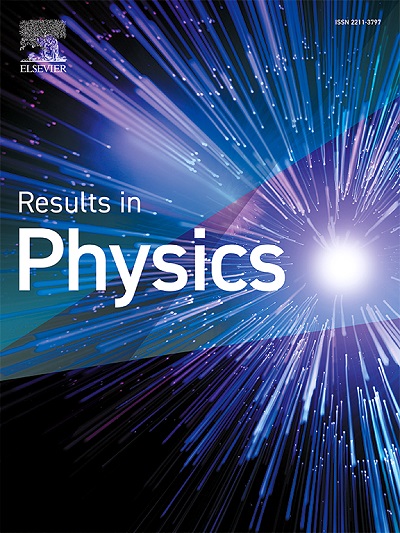Optimal antenna design for wireless energy harvesting system in ISM band
IF 4.4
2区 物理与天体物理
Q2 MATERIALS SCIENCE, MULTIDISCIPLINARY
引用次数: 0
Abstract
In this paper, three different techniques — Coplanar Waveguide (CPW), Via-less Electromagnetic Band Gap (EBG), and Defected Ground Structure (DGS) — are incorporated to enhance the performance of the designed microstrip patch antenna (MPA). The impact of each technique on the antenna is analyzed. The radiation characteristics of the main, CPW, EBG, and DGS MPAs have been presented and compared. The results indicate that the main antenna design achieved a return loss () of −28.3 dB, a gain of 6.31 dBi, a directivity of 7.03 dBi, a bandwidth (BW) of 0.17 GHz, a VSWR of 1.08, and an efficiency () of 84 at the 5.8 GHz ISM (Industrial, Scientific, and Medical) Band. While the CPW technique demonstrated an of −41.3 dB, a VSWR of 1.01, a BW of 2.18 GHz, a gain of 4.05 dBi, a directivity of 4.45 dBi, and an () of 91. Furthermore, the EBG technique resulted in an () of −34.16 dB, a gain of 7.24 dBi, a directivity of 7.84 dBi, a BW of 1.43 GHz, a VSWR of 1.05, and an of 87. The DGS technique provided an () of −34.73 dB, a gain of 6.61 dBi, a directivity of 7.59 dBi, a bandwidth of 1.07 GHz, a VSWR of 1.03, and an () of 80. Notably, the simulation and measurement values are in close agreement with impedance matching of and the surface current distribution is quite homogeneous. The substrate’s material is Rogers 04350B with , the thickness of 1.6 mm, and a loss tangent of 0.0037. The overall size of the proposed design is . The proposed structures have an electrical size of at 5.8 GHz, where . This parametric optimization, combined with the novel integration of techniques, contributes a significant advancement in energy harvesting capabilities, making it the most suitable for wireless energy harvesting systems and biomedical applications.
ISM波段无线能量采集系统天线优化设计
本文采用共面波导(CPW)、无通孔电磁带隙(EBG)和缺陷接地结构(DGS)三种不同的技术来提高设计的微带贴片天线(MPA)的性能。分析了各种技术对天线的影响。介绍了主要海域、CPW海域、EBG海域和DGS海域的辐射特性,并进行了比较。结果表明,主天线设计在5.8 GHz ISM(工业、科学和医疗)频段的回波损耗(S11)为−28.3 dB,增益为6.31 dBi,指向性为7.03 dBi,带宽(BW)为0.17 GHz,驻波比为1.08,效率(η)为84%。CPW技术的S11为- 41.3 dB, VSWR为1.01,BW为2.18 GHz,增益为4.05 dBi,指向性为4.45 dBi, (η)为91%。此外,EBG技术的(S11)为- 34.16 dB,增益为7.24 dBi,指向性为7.84 dBi, BW为1.43 GHz, VSWR为1.05,η为87%。DGS技术的(S11)为- 34.73 dB,增益为6.61 dBi,指向性为7.59 dBi,带宽为1.07 GHz, VSWR为1.03,(η)为80%。值得注意的是,模拟和测量值与~ 50Ω的阻抗匹配非常吻合,表面电流分布非常均匀。衬底材料为Rogers 0450b, r=3.66,厚度1.6 mm,损耗正切为0.0037。建议设计的总体尺寸为50×50×1.6mm3。所提出的结构在5.8 GHz时的电尺寸为0.967λo×0.967λo×0.03λo,其中λo=27mm。这种参数优化,结合新颖的集成技术,有助于能量收集能力的重大进步,使其最适合无线能量收集系统和生物医学应用。
本文章由计算机程序翻译,如有差异,请以英文原文为准。
求助全文
约1分钟内获得全文
求助全文
来源期刊

Results in Physics
MATERIALS SCIENCE, MULTIDISCIPLINARYPHYSIC-PHYSICS, MULTIDISCIPLINARY
CiteScore
8.70
自引率
9.40%
发文量
754
审稿时长
50 days
期刊介绍:
Results in Physics is an open access journal offering authors the opportunity to publish in all fundamental and interdisciplinary areas of physics, materials science, and applied physics. Papers of a theoretical, computational, and experimental nature are all welcome. Results in Physics accepts papers that are scientifically sound, technically correct and provide valuable new knowledge to the physics community. Topics such as three-dimensional flow and magnetohydrodynamics are not within the scope of Results in Physics.
Results in Physics welcomes three types of papers:
1. Full research papers
2. Microarticles: very short papers, no longer than two pages. They may consist of a single, but well-described piece of information, such as:
- Data and/or a plot plus a description
- Description of a new method or instrumentation
- Negative results
- Concept or design study
3. Letters to the Editor: Letters discussing a recent article published in Results in Physics are welcome. These are objective, constructive, or educational critiques of papers published in Results in Physics. Accepted letters will be sent to the author of the original paper for a response. Each letter and response is published together. Letters should be received within 8 weeks of the article''s publication. They should not exceed 750 words of text and 10 references.
 求助内容:
求助内容: 应助结果提醒方式:
应助结果提醒方式:


